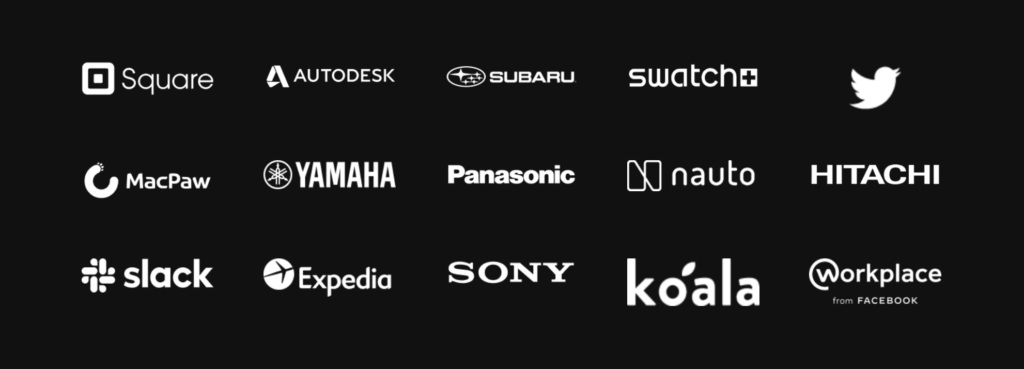Brandon Hill is the founder and CEO of btrax – a design and marketing agency that specialises in Japan and US market entry and growth. Based in San Francisco, he has been running the agency for more than sixteen years and has worked with clients such as Twitter, Square, Expedia and Slack. In this interview, we discuss how he started btrax, what makes software companies successful in Japan and how to market to Japanese consumers.
How btrax got started
I started btrax in 2004. Back then, I was a design graduate living in San Francisco. I was trying to get a job but couldn’t because of the burst of the dotcom bubble. So I decided to start my own company.
Naturally, the company started by providing web design services. Until a friend advised me that since I have a Japanese background — having been born and raised in Japan — I should provide cross-cultural design services. Specifically localising websites in English and Japanese for the US and Japanese markets. I thought that was a good idea.
We started doing that and got drawn into the startup community in San Francisco. At the time, everyone was doing startups. That’s when Twitter got started. And there were also a bunch of other startups like Pinterest, Dropbox and Instagram getting started in San Francisco. There were many events organised in the area to bring people from the ecosystem together. I decided to run our own events with the aim of connecting the startup communities in the US and Japan.
With time, we started to provide ‘Lean Startup’ process development services to Japanese companies. This was in addition to providing localisation services to US companies such as Slack and Twitter to expand or grow their business in the Japanese market. These remain the two main types of services that we provide today.
The state of SaaS in Japan
In order to understand the state of SaaS in Japan, you first need to understand the whole software landscape in Japan. Historically, Japan is well known for large corporations hiring development companies to create custom software for them. That software is hosted on a server inside their office building. To this day, this remains a huge industry.
There have not been many software companies adopting the SaaS model. By SaaS model I mean software available on the cloud that you can sign up and pay monthly fees for like Slack. SaaS offerings tend to be extremely easy to use and are updated frequently with improvements. When you compare this model with that of custom software, the SaaS model is obviously better. Tech startups and a few publicly-traded companies such as Recruit started using cloud-based services. But legacy companies and large corporations such as Toyota prohibited the use of these services due to security concerns. For IT departments in these companies, “cloud” meant ” not secure”. They still preferred their custom software.
However, because of this pandemic, these companies were forced to work remotely. And when working remotely, it’s not convenient to use the custom software located on servers within office premises because you need to use things like VPNs. Those companies started to understand the appeal of SaaS solutions and how secure they actually were. Also, since many businesses in the US were already using these services, they were willing to give it a shot as well.
The superior user experience of SaaS over that of custom software made those services very successful in Japan.
I think this shift led to a lot of people realising how good these cloud-based services are even though they are not customised for their individual needs. The superior user experience of SaaS over that of custom software made those services very successful in Japan. But they now face competition from Japanese startups who are also adopting that model. These startups are developing solutions for things like accounting and human resource management which are Japan-specific. If a market is already taken by one of these local companies, it could be challenging for non-Japanese companies to come and succeed in the market.
Selling software in Japan
The process of selling software in Japan is very unique. Japanese companies tend to prefer the corporate licensing model when it comes to paying for software. They don’t pay by credit card but instead prefer payments to be invoice-based. This is common in Japanese business culture where they prefer to pay everything at once annually for say 3000 people as part of their budget. It is then unlikely that they are going to cancel these licenses during that period.
But it takes more time and patience to get a contract. Generally three to six months of talking to corporate executives on a regular basis and building credibility. It’s rare for Japanese companies to go for things like a 30-day trial. Everything needs to be decided by the executives and board members. That’s the reason why many companies have offices in Japan. The main job of the people working in these local offices are sales management and customer retention. This is important because Japanese businesses expect to receive really good support once they pay for a service. Most SaaS companies however do not provide human support. It’s usually a chat or a message board. But Japanese companies do not like that.
Interestingly, one of the best ways to sell SaaS-based software to businesses in Japan is to tell them that their competitor is already using it.
Interestingly, one of the best ways to sell SaaS-based software to businesses in Japan is to tell them that their competitor is already using it. For example, if Japan Airlines is using a particular software, most likely ANA will start using it as well. Or, if Toyota starts using a new service, then Nissan will start using it too. It’s funny, but that’s how it works. And it’s not limited to Japanese competitors. If Google, Microsoft or Tesla are doing things in a different way, Japanese companies will give it a try too.
From a marketing perspective, this means that activities like case studies are very effective. For example, we’ve worked with Facebook to promote Workplace in Japan. To do so, we invited existing users of Workplace, mostly larger corporations who’ve been using the solution for a while, to join webinars where we’d let them share about their experience with the software. But to do that kind of activity, you need the first notable customers on board. And for that you need to rely on your network.
Marketing to Japanese consumers
One of the key drivers of adoption of software in Japan is intuitiveness. Many people in Japan still don’t feel comfortable using English-based services. But if the product is intuitive enough that you’re able to navigate through the interface without having to read too much text, then it has the potential to become successful without proper localisation. That was the case for Twitter, Evernote, Dropbox and more recently Clubhouse.
Many people in Japan still don’t feel comfortable using English-based services. But if the product is intuitive enough that you’re able to navigate through the interface without having to read too much text, then it has the potential to become successful without proper localisation.
To then accelerate the growth and become attractive to more Japanese users, you need to hire people in Japan to localise the product. Netflix is a great example of a company that has been able to achieve that. They are very successful in Japan. They found the right people to distribute the right content in Japan when they opened their office in Tokyo a few years ago. They have a good mix of local and foreign content. While it’s known that a lot of people in Japan are interested in foreign content such as Hollywood movies, that’s not enough to attract a mainstream audience. The older generations for example prefer to watch something in Japanese.
In terms of promotion, Twitter is a good channel mostly for consumer products. There is also LINE which enables you to have a business account. It is an effective channel for running campaigns and sending things like coupons. News websites are also great for promotion as they are very popular. For example, Yahoo News still gets a lot of traffic in Japan. There’s also a curated news service called NewsPicks which has built a huge customer based. You can run advertising campaigns such as paid articles on such platforms. In fact, Slack has an ongoing paid campaign on NewsPicks.
In terms of device use, you want to target mobile users during commute time when there’s a spike. We’ve been looking at the data and these spikes occur between 7am-9am in the morning at 6pm-10pm at night. During work hours, most activities tend to happen on desktop instead.
TV is still big in Japan. There are a few mainstream national channels with huge audiences that can get you a lot of attention. One of our clients got featured in a morning show recently and it resulted in a pretty considerable increase in sales. Corporate executives prefer advertising on TV rather than on the internet which they trust less. TV actually provides the best return on investment. That is why a company like Dentsu is a huge business.
Helping clients succeed in Japan
Companies reach out to us in two different scenarios. Either at the very early stage of their expansion in Japan or later when something goes wrong.
In the first scenario, companies start seeing some traction from users in Japan. They start thinking about officially expanding into the market but nobody in the company knows about Japan. In this case, we provide them with workshops to educate them about the market. But that is rare because when they do not know about the market, they get a little scared because it seems like a lot of work and they end up procrastinating.
For these customers we do a lot of user testing and user interviews. We talk to customers and potential customers to find out what they need and what they think. We create detailed reports for them. Also, we provide localisation recommendations in terms of design and copywriting. Finally, we also run ad campaigns, create concept videos and engage in influencer marketing on behalf of our clients.
In the second scenario, the company is already established in the Japanese market but they are experiencing some pains when growing. Oftentimes, these companies went into the market by themselves without relying on local expertise. But it is difficult to do so. Many end up reaching out to us after they start experiencing challenges.
This was the case of Twitter for example. They were already in Japan for around ten years. They were doing a good job to the point that Japan became their second largest market after the US. But a gap was created between their local office in Japan and their headquarters in the US. The team responsible for customer management and support was in Japan while the product and marketing team was in the US. The team in Japan were getting frustrated because the product team in the US were not making improvements for the Japanese market fast enough and they were getting complaints from their Japanese customers. That’s when we got into play by making sure that the gap was filled by facilitating knowledge sharing and providing localisation advice for the product team to improve the offering for Japanese customers.
Most people come to us in that second scenario. Because they have to feel that pain before they start looking for a solution.

Thanks to Brandon for answering my questions. You can find him on LinkedIn. You can reach out to btrax if you are interested in the Japanese market to grow your business. Or you can read the btrax blog for more great content on the topics discussed. They also host periodic events.

